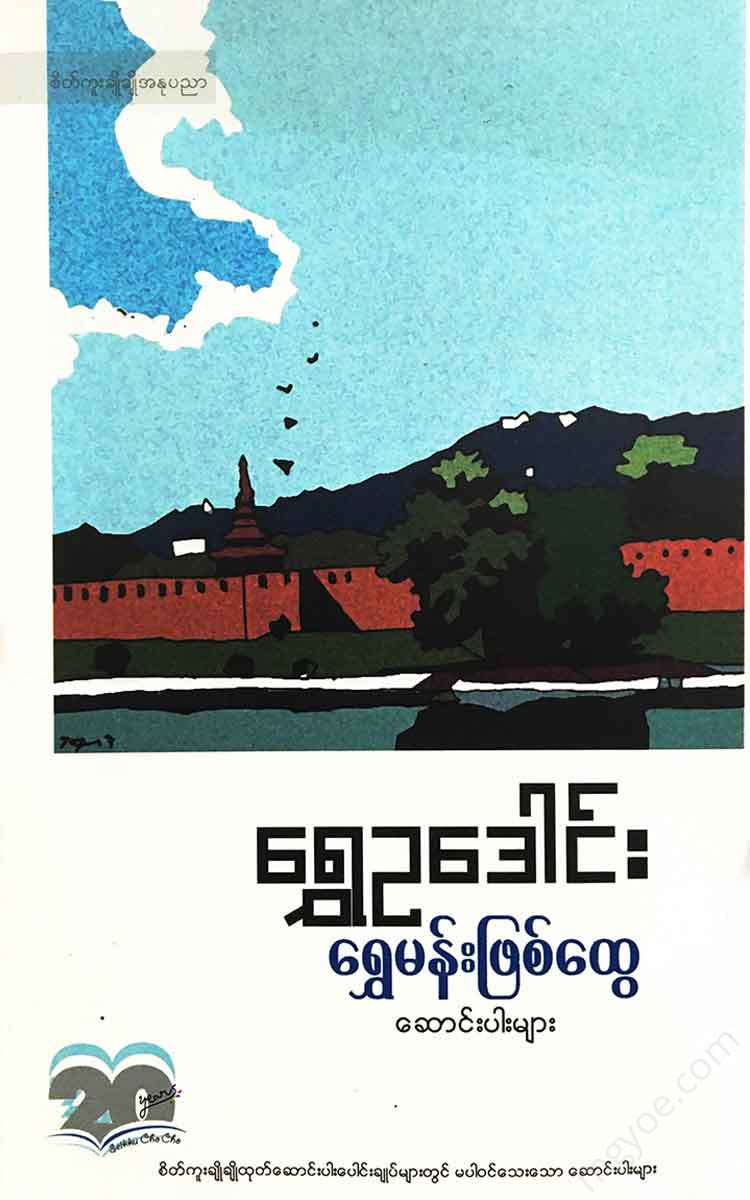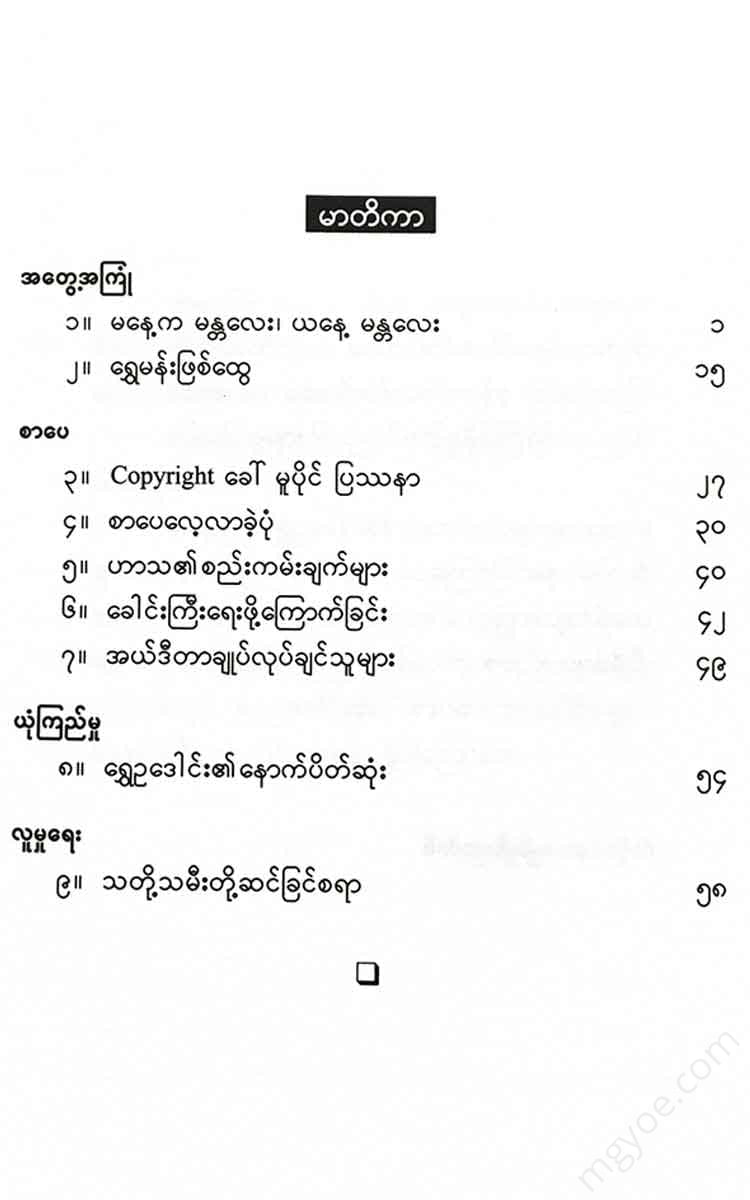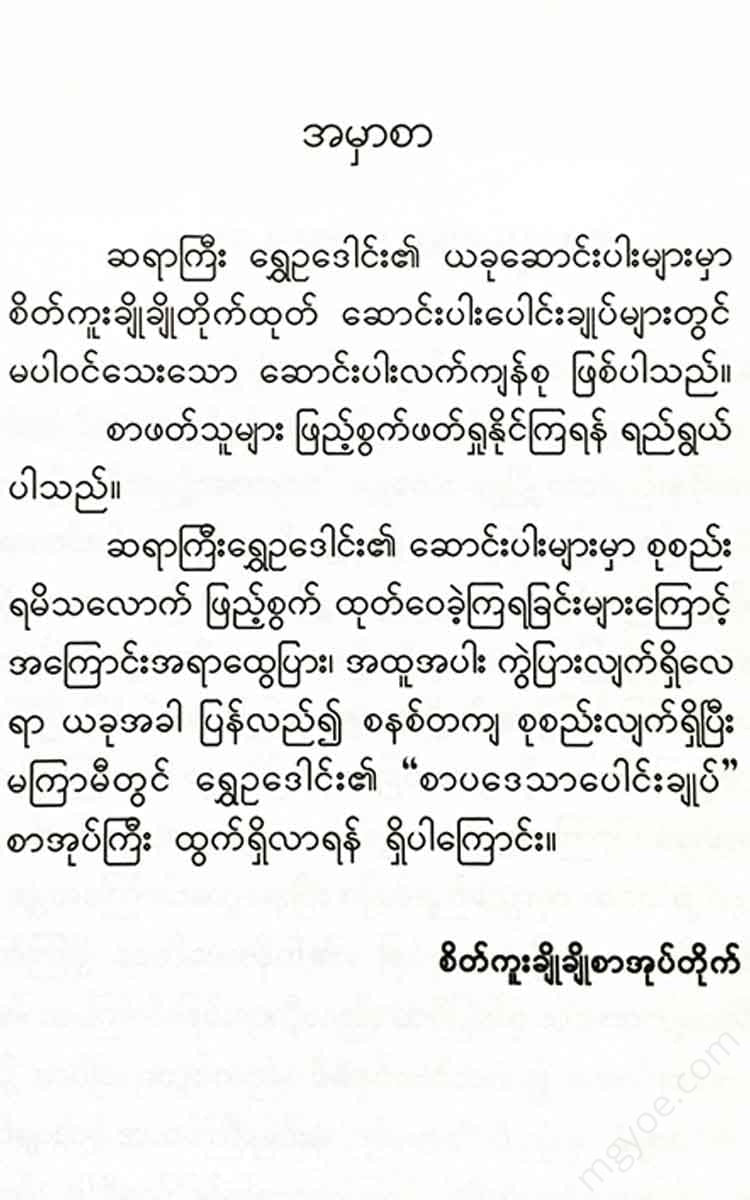စိတ်ကူးချိုချိုစာပေ
Golden Peacock - Golden Man
Golden Peacock - Golden Man
Couldn't load pickup availability
Experience
Yesterday Mandalay, today Mandalay
If a publication is published for the Mandalay Centenary, I feel it is my responsibility as the oldest living Mandalay writer to write an article about the Golden City of Mandalay. In writing this, if I am to write a biography of Mandalay, since Shwe Kaing’s book has already provided a sufficient and complete description, I would like to describe only the situation of Mandalay, not the situation of Mandalay. I would like to warn readers of this article not to think, “I am writing about Mandalay, but I am writing about it and I am writing about it personally.” If I am presenting the situation that I saw, it would be natural to present the situation of the person who saw it. In presenting this, I hope that I will be free from the accusation of being “personally biased” because I am not trying to impress myself with good information, but also with poor and naive details.
Division of two sectors
“ In presenting my view, I will also tell you a little about myself, because out of my 70 years of life, I have spent about 25 years in Yangon. The rest of the time I have lived in Mandalay. Of these 70 years, the first and the latter part of my life were spent in Mandalay, and only the middle part was spent in Yangon. Therefore, my view of Mandalay can be divided into two parts: one part from the past 60 years, and the other part from the post-war period. Here, the situation of Mandalay in my youth (in ancient times) and the perspective of a young person are one part, and the situation of Mandalay in my adulthood (in this era) and the perspective of an adult are the other parts.
The scolding of the Lord
First, I would like to mention one of my weaknesses. I am a descendant of two parents who were court officials. My parents had told me many times about the events in the palace during the reign of King Thibaw to adults in my presence, but I did not take note of them because I was not interested. It can be said that I heard it from the left ear and left it from the right ear. My opinion is that there is no benefit in remembering events from the past. I am interested in events that are relevant to the plot. I did not think that any servant was greater than any servant, or that the queen of the south was more honorable than the queen of the west, and so on. I did not pay any attention to such knowledge because I did not think it was valuable. While I was in Yangon, my father visited me, and my colleague, Saya Lun (now Master Thakin Htet Hmoung), came to my house and spent the night there, asking my father about the knowledge of King Thibaw's reign, which seemed to be very satisfying. In the morning, the Master said to me, "I would like to beat you up if you are raised by such a father and do not memorize the knowledge of the throne."
First thing I remember
The first thing I remember about Mandalay and my life since I became a man is an incident that happened under three big trees in the Mae O Tan Ward, on the Shwe Ta Chaung Myaung Pagoda, north of the Tombs Bridge. The time was in the evening of the Burmese calendar 1255-56 (1893-94). That evening, I was playing with children of my age, four or five years old, on the Shwe Ta Chaung Myaung Pagoda. The game consisted of crossing the cart path, facing south, then suddenly jumping to face north, and then again to face south. (This game, and many other games, have disappeared in this era.) While playing, I fell down with a thud, hit my chin on the ground, and bled profusely. I still remember it. The scar he received at that time is still there today, and in his government service record book , he wrote down “a scar under his chin” in the column labeled “Distinguished Marks.” This was the first thing he remembered in his life, and it was a scar he would never forget (or fade away) until he died.
Place of burial
The above incident happened when I was four or five years old in Mae O Tan Ward, where we lived, but I was not born in that ward. My burial place is called “Echint” which is adjacent to Wa Tan Ward. When my parents were still alive, they wanted to show me the place where I was born (there is no house or car), but they did not ask. Therefore, no one can show me my birthplace, just as I show the birthplace of Min Letwe Sundara to the children of writers in Mangye Tong Village. As the English respect the village of Stamford, the birthplace of Shakespeare in England, the Burmese people who want to pay homage to me will not be able to do so. (Not really, I am just writing this for fun. I have no hope of ever doing so, and I am not a person who enjoys such things.)
Moving at once
I think there are few people in Mandalay who have lived in such a large neighborhood as I have. My parents, who were economically disadvantaged, moved around a lot. After I was born in Achent Ward, we moved to Mae O Tan, Bepaop Tan, Yai Tan, Yan Nga (Yan Ni) Daga, Gand Tan, Wat Lak, Kand Tan, Yan Nga Daga (second time), and Alawi Daga. When I separated from my parents and got married, we moved to Mingalar Daga, Ho Kone, Kand Tan (twice), Gand Tan, Aryataw, San Tan (twice), and Ut Tan, as the saying goes, “Planting banana trees and planting bananas” and “growing bananas” is a common saying. Some people say they are Mandalay residents, but they were born in one place and died there, so they only know their places in detail. But I am someone who knows the above neighborhoods in detail. (It's not pride, it just means a weak foundation.)
The allure of a gold bar
Among the neighborhoods where I lived with my parents, the neighborhoods that I remember the most are Yan Ngo Da and Gand Tan. I remember Yan Ngo Da not because it was a happy neighborhood (in fact, it was a very poor area). It was because I was a student who wanted to remember everything, while Gand Tan was probably because I was a young man who was just starting to make a name for myself. While I was living in Yan Ngo Da , I used to walk every day (except on Sabbaths) to the Dakshinawan Monastery, which is 17'' away from my house, south of the Ein Daw Ya Pagoda. The things I saw on the way are still etched in my mind. When I left home after eating early in the morning, I walked along the Shwe Ta Chaung Myaung Pagoda.





